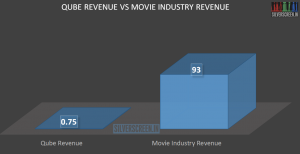The Tamil Nadu Producers’ Council has been waging a months-long war with digital service providers – like Qube Cinema and UFO – accusing them of exorbitant prices and unfair business practices. The battle has intensified over the last few weeks, with the Producers’ Council head Kalaipuli S Thanu and his team holding a symbolic one day fast in protest; and both sides exchanging heated words with each other.
At heart is money.
And like most things Tamil cinema, nothing is what it seems on the surface.
Until the last decade, most movies were shot on film. A lab made multiple copies – or prints – of the movie, and the film was delivered physically to movie theaters for projection. This is how the movie industry the world over functioned for the last fifty years. Tamil movies too were delivered the same way. Except we called the prints flims.
Most movie theaters would play advertising reels at the start of the movie and during the interval midway. Not to mention the consistently hideous Government mandated newsreel about how whoever was in power then was pretty awesome.
Everyone was happy. Then, the Internet happened.

Qube1
Digital distribution was not too far behind. In India, Qube Cinema, founded in 2004 by Senthil Kumar and Jayendra Panchapakesan, was one of the first to offer digital delivery of motion picture media. Qube, through its custom servers, offered the ability to deliver a movie directly to movie theaters. Today Qube controls about 2700 screens in India, and makes money by charging producers a set fee to deliver a movie to a theater.
Qube also became a reseller of advertising space; it negotiated rates (Qube refused to divulge advertising revenue to Silverscreen) with advertisers in bulk, and began inserting advertisements into its media delivery. The closest equivalent in the analog world would be the courier delivering prints to the theaters stopping his scooter midway to insert an advertising reel into the print.
Who gets the advertising revenue in this case? Qube shares advertising revenue with theaters, but not producers. The theaters like the model, the producers don’t. “We make this content and we’re putting in a lot of money into it. By adding five or six advertisements that barely cost ten percent of the feature film, theatres and these providers make a lot of extra money.”
Qube uses popcorn sales to justify its business model – like popcorn sales, ad revenue belongs to theaters. Qube gets money for being nice to theaters and inserting advertisements.
A source close to Thanu, speaking to Silverscreen, said that the veteran producer is ‘very intent’ on finding a resolution as soon as possible. “One of the promises Thanu and his team made when they were elected to the Producers’ Council was to bring down digital distribution rates. He is devoting all of his energy towards it in an effort to further secure his position in the council,” the source added. Thanu and his team are now demanding a fifty percent revenue sharing model with the providers. Furthermore, they also want to get money from Qube for movies that they already delivered.
[quote align=’left’]With 2700 screens, the revenue estimate seems low; assuming that a theater screens about 20 different movies a year, Qube should have a revenue of at least ₹120 crores per year not counting advertising revenue.[/quote]Senthil Kumar, co-owner of Qube, denies the claim that it charges too much money. “Our prices have been the same since 2005. We have transformed the Indian Cinema industry over the past few years. During the nineties, there was strong competition from satellite television. It was only due to our technology that audiences flocked back to the theatres.”
Even in a battle where both sides are prone to hyperbole, this claim seems over the top. Satellite television still exists. One will still be hard-pressed to find somebody that wants to watch a movie because it is delivered by Qube.
Speaking about revenue sharing, Senthil Kumar added that a decision on sharing revenue can only be taken by the theatre owners. “Historically speaking, ad revenue has always been given to theatres. We have water tight legal agreements with them, and so it is to these people that producers must appeal to. Not us. As it is, we barely make even. All this talk of overcharging and fleecing is pure slander.”
Qube charges producers a ₹22,500 flat rate per screen for each movie they deliver. The company is privately held, and is not obliged to disclose financials; but it did say that its revenue was around ₹75 crores (₹750 million). With 2700 screens, the revenue estimate seems low; assuming that (on average) a theater screens about 20 different movies a year, Qube should have a revenue of at least ₹120 crores per year not counting advertising revenue.
Also, while a surface reading of Qube’s claim that their prices have remained unchanged over five years seems like a win for the producers, it is difficult to make sense of the numbers without advertising revenue. Also, ticket prices – mandated by the Tamil Nadu Government – have stayed steady for the last several years.
Actor Sarath Kumar, president of the Nadigar Sangam, has voiced his support for the producers and alleged that costs had actually increased once theatres went digital. “Tamil Cinema is going downhill recently and is facing lots of problems. I humbly request QUBE, UFO distribution networks to work with us to make the situation better. Earlier the movies which were released in reels, cost only Rs 75,000. Now with digital innovations and new projectors, the cost has risen to around Rs 5 Lakhs . The projection companies themselves arrange for loan amount and after that they gain even more from advertisements. I request them to share profits with producers so that a healthy environment of trust can be established.”
He also asked the State Government to step in and take control of these companies so that the fee structure can be standardised. “Like they did with Cable Television in TN, the Government should also take over digital service providers. Till now there is no set fare system. Maybe with the Government’s involvement, we can achieve better results.”

Qube2
Qube’s Senthil Kumar also added, “Usually the practice is to collect fee for mastering a film into the digital format. But we don’t do that. We have done a lot of good, but due to a deliberate campaign that discredits us, we’re being made to look evil.”
In an ultimatum, the Producers’ Council gave the companies time till May 29 to respond to their demands. “If their response is not to our favour, we will stop movie releases from June 12 onwards. This is a drastic decision, but there is no other way forward. We have come to this decision after a lot of discussion. All the trade organizations are in agreement with us. We are united in this issue.”

Qube3
Every year, the Tamil film industry makes more and more movies. 2014 saw a record 220 Tamil films released, with only 35 to 40 of them breaking even. The other 80% of movies made losses, and this 20-80 trend has persisted over several years.
There has been no corresponding growth in movie infrastructure; the number of theaters has stayed steady, and competition from alternative forms of entertainment has only grown: Television soap operas, the IPL, DVDs, Hollywood, Bollywood, an apathetic young population.
Yet, producers churn out mindless movies each week. The last few weeks of 2014 saw intense competition for limited screens and some weeks saw as many as 20 releases. Qube, with its fixed price model, walked away with a lot of money.
The Tamil film industry has been mired in an intense debate over financials this past year. Are actors paid too much money? Do
financiers charge too much interest? And now, do exhibitors charge too much money per print.
Yet nobody asks the obvious question, do producers in Tamil make too many movies? Can an industry like this support over 200 releases a year?
Except for the occasional Soodhu Kavvum, the average low budget film almost never makes money. Yet small time producers still behave like established ones, and try to get their movies wide releases all over the state. There are almost no movies made in Tamil that target niche and try to make money back through limited release. And when they fail to make their money back, producers want to blame everyone but themselves.
People watch Television.
Fake DVDs were why my movie with terrible production values and no story flopped.
The Marina beach was open too long this month.
Qube ate my money.
Everyone that produces a movie gets a seat on the Producers’ Council. The council operates by majority vote. Next month, rules come into play that allow big budget films to release only on certain days of the year. In any other universe, that plan would be laughed at.
Like allowing good restaurants to stay open only on certain days of the year. Like allowing the Chennai Super Kings to only play every fourth IPL. The theory is that if you only screen low budget movies, people will be forced to watch them.
Right.
There is also a simpler explanation for this particular issue with digital distribution. Unconfirmed reports suggest a long time Tamil producer, wants to start a digital distribution network of his own.
Nuance, uncertainty. A corporation that may or may not be the villain. Nothing is what it seems to be. If only Tamil movies had as much intrigue on screen…



